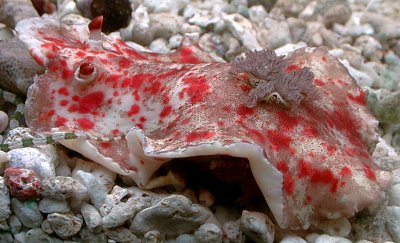
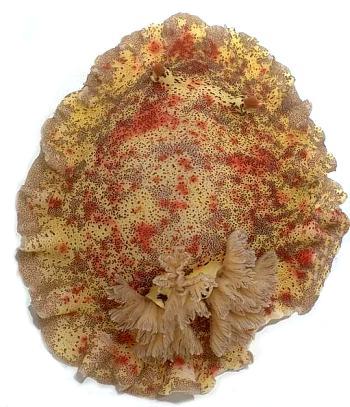
Platydoris formosa
(Alder & Hancock, 1864)
Order: NUDIBRANCHIA
Suborder: DORIDINA
Superfamily: EUDORIDOIDEA
Family: Dorididae
DISTRIBUTION
Tropical Indo-West Pacific.
PHOTO
UPPER: on top of the reef at Faga'alu, west Pago Pago Harbor, American Samoa. 4 September 2000. Photo: Don Barclay.
LOWER: Msasani Bay, Dar es Salaam, Tanzania, September 1974. Photo: Bill Rudman.
Very similar to Platydoris scabra, with fine brown specks, but differs in having large red patches (as in Platydoris cruenta), and bright red rhinophore clubs. The underside of the mantle is white with fine brown specks on the inner half and larger red patches all over. It has characteristic patches of brown specks and large red. This group of similarly coloured species is discussed under P. scabra. The original description of Doris picta Kelaart, from Ceylon, describes both dorsal and ventral surfaces to be splashed with large and small brick red spots. This is not obvious from the illustration later published (Eliot, 1906). However Eliot's description of the type specimen and its radula clearly indicate a species of Platydoris, and almost certainly the species later described from nearby India as D. formosa. As the name D. picta is preoccupied by two earlier usages, Doris formosa is the earliest available name. The specimens reported here from Zanzibar, and this photograph of a specimen from New Caledonia, and records from Hawaii (Kay & Young, 1969), suggest a wide Indo-West Pacific distribution. Grows to about 15cm long.
Reference:
• Alder, J. & Hancock, A. (1864). Notice of a collection of nudibranchiate mollusca made in India by Walter Elliot Esq., with descriptions of several new genera and species. Transactions of the Zoological Society of London, 5: 113-147.
Rudman, W.B., 2000 (September 11) Platydoris formosa (Alder & Hancock, 1864). [In] Sea Slug Forum. Australian Museum, Sydney. Available from http://www.seaslugforum.net/find/platform
Related messages
Platydoris formosa trailing
April 3, 2007
From: Reindert Grooters and Mieke Snoek
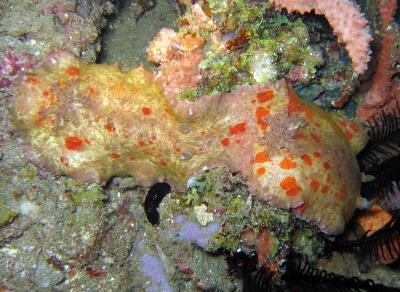
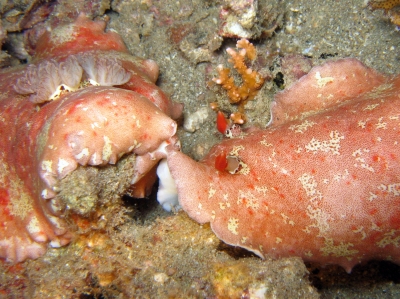
Hello Bill,
Here we see trailing behaviour of Platydoris formosa from two different night dives on two different locations around Anilao. Is this common for this species as it is for Risbecia tryoni?
Locality: Anilao, Batangas, 8 metres, Philippines, western pacific, 15 and 17 November 2005, Sand and coral patches. Photographer: Reindert Grooters.
Thanks,
Reindert & Mieke.
mieke.reindert@chello.nl
R. Grooters; A. Snoek, 2007 (Apr 3) Platydoris formosa trailing. [Message in] Sea Slug Forum. Australian Museum, Sydney. Available from http://www.seaslugforum.net/find/19424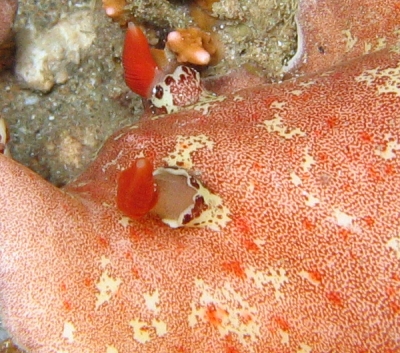
Dear Reindert & Mieke,
I can't recall a report of trailing in species of Platydoris before, but it seems quite a widespread behaviour. Perhaps its just more noticeable in relatively active species like chromodorids and some sea hares.
I have included a close-up alongside to show the colour pattern of this species and also the spectacular red rhinophores.
Best wishes,
Bill Rudman
Platydoris formosa from the Philippines
May 22, 2001
From: Mary Jane Adams
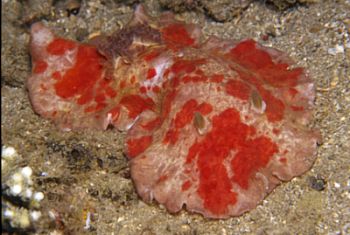
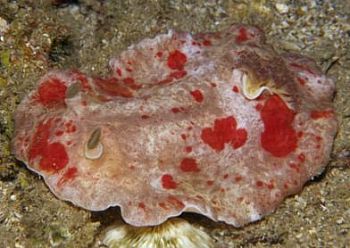
Hi Bill,
I found these two Platydoris formosa in a very strange place -- at the bottom of a barrel sponge! They were thrashing around as if trying to find a way out. When I picked them up they were tightly curled and felt hard and stiff. I put them on the sand to photograph them and was amazed to see them flatten and stretch out to about 18 cm in length.
Depth: about 10 meters, Divesite: Twin Rock, Batangas, Philippines, May 8, 2001.
Best regards,
Mary Jane
divepng@yahoo.com
Adams, M.J. , 2001 (May 22) Platydoris formosa from the Philippines. [Message in] Sea Slug Forum. Australian Museum, Sydney. Available from http://www.seaslugforum.net/find/4382Thanks Mary Jane,
These 'red-splashed' or 'blood-spattered' platydorids are an amazing sight. Withour the red they would be almost invisible, so why the brilliant display. Perhaps their potential predators can't see the red? We have only just begun to realise just how complex the topic of colour and colour display is in these animals. One thing we can be sure of - the obvious answer is the least likely to be correct.
Cheers,
Bill Rudman
Platydoris formosa from Samoa
September 12, 2000
From: Don Barclay

Hello Bill,
Thanks for looking at the little Diniatys. I'll send you a photo of the empty shell when I get it clean (if I don't crush it).
No more micro-bubbles tonight. Here's a big nudibranch collected about 2200 local time, 4 September 2000, on top of the reef at Faga'alu, west Pago Pago Harbor. It looks a lot like Platydoris cruenta, but all of the P. cruenta I've seen here are orange-splotched with the brown hair-like markings. They also have brown or orange tipped rhinophores. This big guy, 128mm long, has very crimson red rhinophores on white, retractable stalks, and blood red spots on a mottled background without any of the usual markings. Is it an unusual P. cruenta or something else?
Thanks for your help,
Don
n5ols@samoatelco.com
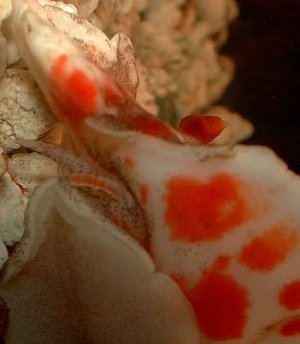
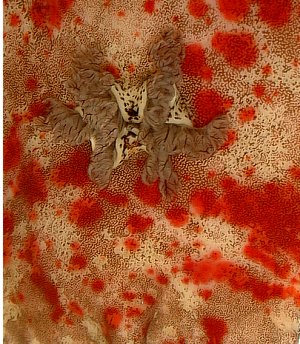
Dear Don,
Messages like this just make me realise what is not on the Forum! I can't believe any Indo-Pacific species of Platydoris have made it yet. Your animal is Platydoris formosa. It is very like Platydoris scabra but with big red spots, just like Platydoris cruenta is P. striata with red spots.
To answer your question I have prepared pages on three of these species. I can't find a good photo of P. striata so if anyone can help out I would be gratful.
Best wishes,
Bill Rudman.
